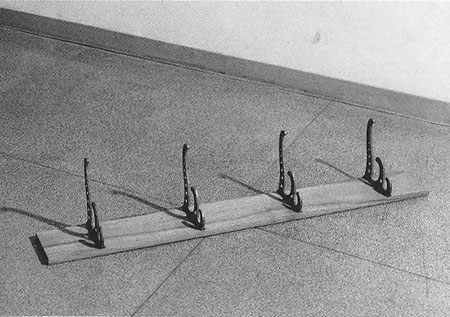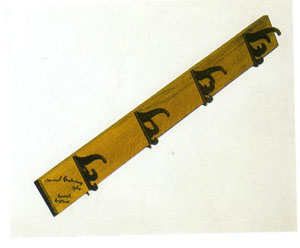
Trap
or
Trebuchet
 |
| Original version, 1917 |
|
Original Version:
1917, New York |
In 1953, Duchamp described this Readymade in the following manner to Harriet Janis:
A functional, household item rendered useless, Trap is a "three-dimensional pun" with references to Duchamp's obsession with chess as well as his aim of trying to 'trip up' the viewer (Schwarz 655). Joselit points out that "trebucher," a word remarkably similar to the title of this Readymade, is a chess term for "a pawn placed so as to 'trip' an opponent's piece" (160). Judovitz defines "trebucher" as "[to] stumble over," thus suggesting the impediment and stumbling that puns inherently engender (94-5). This coat rack, purposely displaced from its original function when nailed to the floor, physically and mentally "trips us up" like puns do (94-5). Joselit explains Trap's relationship to chess in the following manner: "[It embodies] the migration of the game, in the guise of a trap, into the realm of everyday life... chess therefore meets art... by its projection outward into the realm of the readymade" (160).
The phallic pegs of this piece (which remind one of those also seen in Duchamp's Bottle Rack and Hat Rack) support a sexual interpretation of the piece. They lead to Trap's identification as a "male" Readymade.
Finally, the title may also refer to the general trap of trying to definitively interpret, or nail down the Readymade's meaning.
Replicas:
1) June 1964, Milan
"A real coat hanger that I wanted sometime to put on the wall and hang my things on but I never did come to that - so it was on the floor and I would kick it every minute, every time I went out - I got crazy about it and I said the Hell with it, if it wants to stay there and bore me, I'll nail it down… and then the association with the Readymade came and it was that" (Joselit 160).

Replica, 1964

Replica, 1964
Edition of eight replicas
Produced under Duchamp's supervision from photographs of the lost original